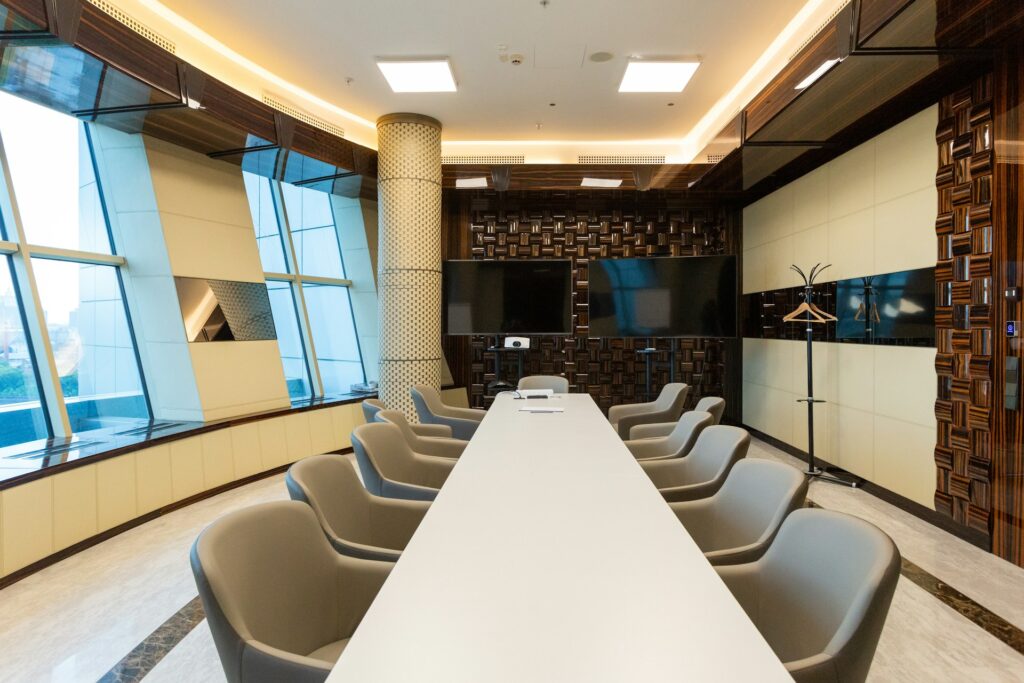
Are technology hiccups slowing down your meetings or presentations? The right audio visual installation in a conference room makes the difference between engaging, productive meetings and frustrating, time-consuming delays. Choosing AV equipment isn’t just about picking the latest gadgets. It’s about designing a meeting room setup that matches your team’s real needs, fits your space, and supports your business goals.
In this blog, you’ll learn how to identify the AV essentials for any conference room, from selecting a display and sound system to integrating control solutions. We’ll cover the key types of AV equipment, offer a practical checklist, and highlight best practices for choosing the right technology partner. Whether you’re equipping your first small meeting room or upgrading a corporate boardroom, this guide takes you through everything you need to know.
Understanding the Needs of Your Conference Room
Define How the Space Will Be Used
Before searching for equipment, define the main functions of your conference room. Are your meetings primarily in-person, fully remote, or is hybrid collaboration the norm? List common activities, such as presentations, video conferences, brainstorming sessions, or training workshops. Knowing these details ensures your audio visual installation supports actual business requirements, avoiding waste or costly upgrades later.
Assess Room Size and Acoustics
The physical characteristics of your space guide which AV equipment is needed. A large boardroom with high ceilings may require different microphones and speakers compared to a small huddle space. Pay attention to factors like wall materials, windows, and ambient noise. If possible, bring in an AV specialist to evaluate acoustics and recommend adjustments, such as soundproofing or acoustic treatments.
Selecting the Right Display Technology
Comparing Display Options
Your display is often the focal point in any meeting room setup. The main options include flat-panel LED screens, laser projectors, and interactive whiteboards. LED displays are ideal for clarity and brightness, especially in well-lit rooms. Projectors work well for larger spaces or when a bigger image is needed, but they can suffer from glare in brightly lit areas. Interactive whiteboards bring a collaborative element, allowing teams to brainstorm and annotate directly on the display.
Sizing and Placement Matter
A common mistake is choosing a display that is too small or poorly placed. Use the “4-6-8” rule as a guideline (the distance from the furthest seat to the screen should be 4 times the screen’s height for analytical viewing, 6 times for detailed viewing, and 8 times for general content). Ensure there are no obstructions or light sources behind the display that could impact visibility.
Achieving Crystal Clear Audio for Every Seat
Microphone and Speaker Selection
Crystal clear audio is non-negotiable for effective communication. Consider ceiling array microphones for large rooms, which capture voices evenly, or tabletop mics for smaller setups. Advanced wireless microphones offer flexibility and mobility for presenters.
For speakers, distributed ceiling or wall-mounted speakers provide even sound coverage in larger spaces, while soundbars work well for smaller rooms. If your conference room AV setup supports teleconferencing, prioritize full-duplex audio systems—which allow participants to talk and listen at the same time without echo or feedback.
Managing Acoustic Challenges
No matter the hardware, poor room acoustics will undermine sound quality. Use carpet, curtains, or acoustic panels to absorb excess noise and echoes. For rooms with glass walls or open layouts, portable sound barriers and digital signal processors help manage echoes and improve clarity.
Ensuring Seamless Video Conferencing Capability
Choosing a Camera
Video calls and remote meetings are now standard. Select a camera with at least 1080p resolution for crisp images, but consider higher resolution if the room is large or if you often present fine details (like architectural drafts or data sheets). Pan-tilt-zoom (PTZ) cameras are adaptable for larger rooms, enabling the camera to follow speakers or focus on audience members as needed. For smaller rooms, fixed wide-angle cameras suffice.
Integrating Conference Platforms
Your AV equipment should be compatible with popular conferencing solutions like Zoom, Microsoft Teams, or Google Meet. Many systems now support direct hardware integrations, so team members can start a video call with a tap or voice command. Ensure that software and firmware are regularly updated for maximum security and performance.
Simplifying Control with User-Friendly Systems
Centralized Controls
The best meeting room setups are easy to use. Install a control panel on the conference table or wall that lets users manage displays, adjust audio, and launch video calls with minimal training. Touchscreens are intuitive, and some even allow control via smartphones or tablets.
Automation and Scheduling
Advanced control systems can automate lighting, blinds, and climate settings together with AV functions. Schedule your rooms and automate equipment to power on or off according to meetings. This adds convenience, reduces energy usage, and extends the life of your AV investment.
Building in Flexibility and Scalability
Planning for Future Growth
Business technology evolves rapidly. Select AV equipment and audio-visual installation methods that allow upgrades or expansions, like adding new cameras, wireless presentation devices, or support for new conferencing platforms. Modular systems and wireless solutions offer flexibility as your needs change.
Supporting Hybrid Work
Many modern conference rooms now accommodate both in-person and remote attendees equally. Invest in technology that actively supports this workflow, such as auto-framing cameras, smart whiteboards, and advanced collaboration tools that sync data in real-time across devices.
Partnering with the Right AV Installation Experts
What to Look For in an AV Partner
Selecting a professional audio visual installation provider is just as important as choosing the right hardware. Look for companies with experience in business technology, preferably with positive referrals and case studies from similar clients. A good partner helps with initial design, installation, staff training, and ongoing support.
Importance of Support and Maintenance
AV equipment requires regular maintenance for consistent performance. Partner with providers who offer service contracts, remote monitoring, and quick-response troubleshooting. Proactive support minimizes disruptions and extends the life of your investment.
Getting Started with Your Conference Room AV Upgrade
The right AV equipment turns your conference room into a hub for teamwork, creativity, and decisive action. By considering your space, future-proofing your technology, and securing expert support, you set your business up for success in every meeting.
Looking for help with your meeting room setup? Contact a professional audio visual installation provider for a personalized walkthrough. A tailored business technology solution boosts productivity, encourages collaboration, and ensures your investment serves your team for years to come.




